总结
数组方法
concat
**concat()** 方法用于合并两个或多个数组。此方法不会更改现有数组,而是返回一个新数组。
返回全部的集合,返回集合成的数组
var arr1 = ['a','b','c'];console.log(arr1);var arr2 = ['d','e','f'];console.log(arr2);var arr3 = arr1.concat(arr2); //["a", "b", "c", "d", "e", "f"]var arr4 = arr2.concat(arr1); //["d", "e", "f", "a", "b", "c"]console.log(arr3);console.log(arr4);
toString
**toString()** 返回一个字符串,表示指定的数组及其元素。
数组转字符串有,逗号
var arr5 = ['a','b','c','d'];var arr6 = [1,2,3,4,5,6,7];console.log(arr5.toString()); // a,b,c,dconsole.log(arr6.toString()); // 1,2,3,4,5,6,7
slice
**slice()** 方法返回一个新的数组对象,这一对象是一个由 begin 和 end 决定的原数组的浅拷贝(包括 begin,不包括end)。原始数组不会被改变。
https://developer.mozilla.org/zh-CN/docs/Web/JavaScript/Reference/Global_Objects/Array/slice
参数开始下标(键名),结束下标,前闭后开[begin,end),不包括end,end之前
与arr的结果一样,但是存储不同的空间地址,相当于拷贝了一份,把新的空间地址赋值给arr1
[bcdef]
从下标1开始截取
截取到4之前,而不是之后
de -1之前由小到大
// slice// [start,end) => (start,end)var arr7 = ['a','b','c','d','f'];var arr8 = arr7.slice(3); // ["c", "d"]console.log(arr8);
join
加入**join()** 方法将一个数组(或一个类数组对象)的所有元素连接成一个字符串并返回这个字符串。如果数组只有一个项目,那么将返回该项目而不使用分隔符。
var arr = ['a','b','c','d'];var str1 = arr.join('-');console.log(str1); // a-b-c-d
split
分隔**split() **方法使用指定的分隔符字符串将一个[String](https://developer.mozilla.org/zh-CN/docs/Web/JavaScript/Reference/Global_Objects/String)对象分割成子字符串数组,以一个指定的分割字串来决定每个拆分的位置。
参数:(以什么为间隔符,数字截取几位)
var arr = ['a','b','c','d'];var str1 = arr.join('-');console.log(str1); // a-b-c-dvar arr1 = str1.split('-');console.log(arr1); // ["a", "b", "c", "d"]
类数组
类数组定义
1)拥有length属性,其它属性(索引)为非负整数(对象中的索引会被当做字符串来处理);
2)不具有数组所具有的方法;
类数组vs数组
探究
打印arguments 结果很像一个数组

看看能不能调用push方法,结果报错


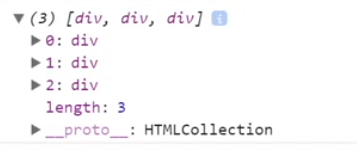
如果加push,依然会报错
为什么没有push,因为不是真正的数组Array,不继承Array.prototype
一定有length属性
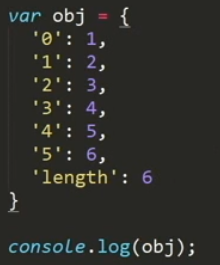
自己写的类数组,打印结果不是符号不是[],而是{}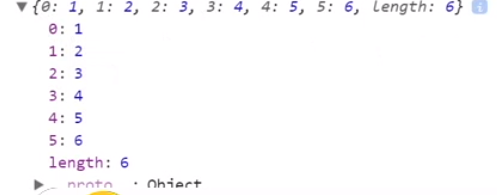
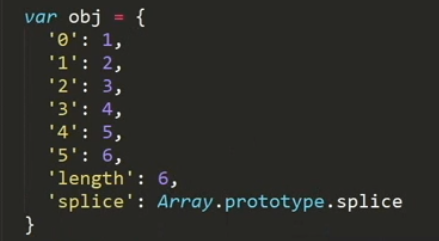
加上splice继承splice
结果就变成了【】
类数组没有push也可以继承
因为所有对象都继承自object.prototype ,所以在它上面添加方法,新建方法并指向array的方法中
Object.prototype.push = Array.prototype.push;//在Object原型中新建push方法,不是重写,Object原型中没有push方法function test() {var arr = [1,2,3,4,5,6,7];arguments.push(8); // 不继承=> Array.prototypeconsole.log(arguments,arr);}test(1,2,3,4,5,6,7)
argument继承object,数组继承Array
function test() {arguments.push(7); // 不继承=> Array.prototypeconsole.log(arguments);}test(1,2,3,4,5,6,7)
如何解决
Object.prototype.push = Array.prototype.push;function test() {arguments.push(8); // 不继承=> Array.prototypeconsole.log(arguments);//Arguments(8) [1, 2, 3, 4, 5, 6, 7, 8, callee: ƒ, Symbol(Symbol.iterator): ƒ]}test(1,2,3,4,5,6,7)
push原理
使得push时length加1
Array.prototype.push = function (elem) {this[this.length] = elem;this.length++;}
Object.prototype.push = Array.prototype.push;function test() {arguments.push(8); // 不继承=> Array.prototypearguments.push(9)arguments.push(10)console.log(arguments);}Array.prototype.push = function (elem) {this[this.length] = elem;this.length++;}test(1, 2, 3, 4, 5, 6, 7);
Arguments(10) [1, 2, 3, 4, 5, 6, 7, 8, 9, 10, callee: ƒ, Symbol(Symbol.iterator): ƒ]
依然是length变成10
push面试题
var obj ={'2':3,'3':4,'length':2,'splice':Array.prototype.splice,'push':Array.prototype.push}obj.push(1);obj.push(2);console.log(obj);//obj[2] = 1;//obj[3] = 2;
参考push原理 push根据数组的length属性为索引确定数组位置添加数组元素
此时this.length 等于 2 elem = 1 => this.length 等于 3 elem = 2 => this.length 等于 4
属性是字符串,obj.name转换成obj[‘name’],name转换成字符串,obj.1错误,1不会转换成obj[‘1’]
因为length是2默认是2,从obj[2]开始,obj[1],obj[2]都是空的
obj[2]=1,length+1=3 ,obj [3]=2, length+1=4

既是类,又有数组的特性,length的长度跟随着012的个数,不看别的属性的个数,一定要有length属性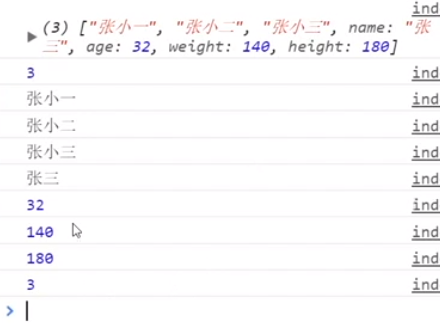 ,
,
作业:
1.封装typeof
function myTypeof(val){var type = typeof(val);var toStr = Object.prototype.toString;var res = {'[object Array]': 'array','[object Object]': 'object','[object Number]': 'object number','[object String]': 'object string','[object Boolean]': 'object boolean'}if(val === null){return null; //先判断是否是null类型因为 null 是特殊的object型 如果是的话就先排除}else if(type === 'object'){ //判断是否是引用类型的数据var ret = toStr.call(val); //判断具体的引用类型return res[ret]; //返回对象中具体的引用类型}else{return type; //若不是引用类型的数据 则直接返回type类型数据}}console.log(myTypeof(new Number(1)));
2.数组去重
var arr = [1, 1, 'true', 'true', true, true, 15, 15, false, false, undefined, undefined, null, null, NaN, NaN, 'NaN', 0, 0, 'a', 'a', {}, {}];Array.prototype.unique = function(){var temp = {},newArr = [];for(var i = 0;i<this.length;i++){if(!temp.hasOwnProperty(this[i])){temp[this[i]] = this[i];newArr.push(this[i]);}}return newArr;}console.log(arr.unique())
解题思路: 利用键名唯一的特性__hasOwnProperty
设置一个空对象,遍历数组 判断传入的每个数组元素是否为其属性 如果不是则空对象传入此属性
新数组加入此元素.
字符串去重
var str = '1122333aaaabbbbb';String.prototype.unique = function(){var temp = {},newArr = '';for(var i=0;i<this.length;i++){if(!temp.hasOwnProperty(this[i])){temp[this[i]] = this[i];newArr+=this[i];}}return newArr;}console.log(str.unique());


